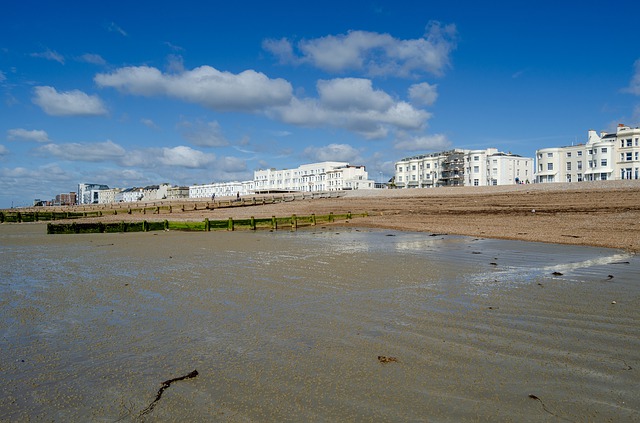By Tim Lambert
Early Worthing
Worthing began as a Saxon village. It may have been called Worth or Wurtha ingas which means the settlement (belonging to) the people of Worth or Wurtha. Whatever the origin of its name for centuries Worthing was just a hamlet where farmers lived. However, in the 18th century, its fortunes changed.
In the 18th century people believed that bathing in seawater could heal you from many diseases. In the late 18th century visiting the seaside became fashionable among the rich. Many new seaside resorts grew up such as Brighton and Bognor Regis.
Worthing began to develop after 1798 when Princess Amelia came. Where members of the royal family went other wealthy people were bound to follow. In the earliest years of the 19th century, Worthing grew rapidly and several new streets were built but in the mid 19th century, the growth slowed.
19th Century Worthing
In 1807 the first theatre in Worthing opened. Also in 1807 Princess Charlotte, the Prince Regent’s daughter visited Worthing.
In 1803 an Act of Parliament formed a body of men called Commissioners who had powers to pave and clean the streets. This was the beginning of local government in Worthing. A Town Hall was built in Worthing in 1835.
Then in 1845, the railway reached Worthing. The railway, of course, made it much easier for visitors to reach the town.
Amenities in Worthing slowly improved. From 1810 Worthing had a market. In 1829 a dispensary opened where the poor could obtain free medicines. In 1881 a hospital opened in Worthing. From 1834 Worthing had gaslight. From 1857 it had a piped water supply.
The first pier at Worthing was built in 1862. It was replaced by a new pier in 1889.
However, not everything went smoothly in Victorian Worthing. In 1850 tragedy struck when a ship called the Lalla Rook was caught in a storm offshore. Some fishermen set out to rescue it but their boat sank. All eleven of the crew died. A second rescue boat was sent out and managed to rescue the crew of the Lalla Rook.
The Salvation Army met fierce opposition when it came to Worthing in the early 1880s. The opposition reached a peak in 1884 when rabble formed themselves into what they called the ‘skeleton army’ and rioted in Worthing. Troops were called in to disperse them.
Worthing was made a borough in 1890. By then it had a population of around 16,000. However, in 1893 there was an outbreak of typhoid in Worthing which killed 188 people. In 1896 the first public library opened in Worthing.
Modern Worthing
In 1901 Worthing gained an electricity supply. Worthing Museum and Art Gallery opened in 1908.
In the early 20th century Worthing flourished as a seaside town and the population grew rapidly. By the late 1930s, it was estimated to be 62,000. The Dome was built in 1910. The Connaught Theatre was built in 1914. The Pavilion Theatre followed in 1926.
Meanwhile, Denton Gardens opened in 1924. Marine Gardens were created in 1930.
On a more sober note, a War Memorial was erected in 1921. Furthermore, in the 1920s and 1930s, the first council houses were built in Worthing. A new Town Hall was built in Worthing in 1933. Also in 1933, the writer Maureen Duffy was born in Worthing.
However, during the Second World War, 44 people died in Worthing as a result of air raids, and 97 houses were destroyed.
In the late 20th century Worthing continued to develop. Worthing Lido opened in 1959. Highdown Gardens were given to the council in 1967 and the Guildbourne Centre opened in 1974. A new library was built in Worthing in 1975.
Davidson Leisure Centre opened in 1989 and Millennium Garden opened in 2000. Today Worthing is a flourishing town.

In 2023 the population of Worthing was 111,000.